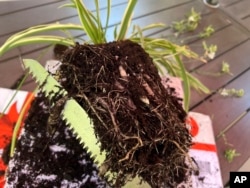How to Bring Houseplants back Indoors
When the cooler autumn days come in the northern part of the world, people clear out old plants and plan new gardens for next year. However, plants that have spent the summer days outside also need help to return to the indoor environment.
Plants that have spent time outdoors
When the plants have grown larger than theirs original Containers during their time outdoors, you can transplant them into larger ones. Choose a container that is no more than 5 centimeters wider than the original. And plant them with fresh potting soil and then water.
You can always split plants like spider plants and anthuriums into two or more individual plants. Look for plants with root systems that tuft together. They share more easily.
If you are having trouble removing the plants from their containers or pots, check to see if the roots have come through the plants drainage holes in the bottom of the pot. If this is the case, gently pull or cut the extra roots to remove the plant.
Then you can divide the plants.
First, gently shake off excess soil.
Second, find the connection between the root system and the top growth of the plant and gently pull the roots apart. Or you could cut them with a sharp knife. Make sure each new plant has at least three healthy leaves hanging from the root system.
Finally space everyone new plant in its container. Be sure to use fresh soil mix. Water the plants well until new plants form.
All indoor plants that have spent time outdoors should be moved into one shady area for a week before going into the winter season. This will help the plant get used to lower light conditions. Keep watering regularly during this time.
After a week, look for insects on the plant, especially under the leaves. Wash the leaves with water to ensure no uninvited guests such as pests. If you are still afraid of insects, you can spray them Plant with neem oil mixed with water. And complete the move before temperatures drop below 50 degrees Fahrenheit.
Plants left indoors
Houseplants that have stayed indoors all summer also need care. Less sunlight and shorter days can slow their growth.
Most houseplants are dormant in fall and winter. This means they require less water and little to no water fertilizer until next spring. Do not overwater during this time. It could cause the roots to go bad.
Check for humidity into the ground by sticking your finger in the pot. When the top few inches are dry, you can water the plant. Avoid pruneing the plants until spring as slower growth in winter means slower healing, but you can prune any dead and dying leaves.
Many houseplants are tropical, Therefore, they need more moisture in the air, the so-called humidity. In most homes, the air can be very dry in winter due to heating systems.
You can run a humidifier, a machine that produces moisture for the air. Place the plants in the room with the humidifier. Keep plants away from dry heating surfaces such as air vents and from cold areas of the house.
As soon as the temperatures in spring are permanently above 15.5 degrees Celsius, you can put the plants outside again without hesitation.
I’m Faith Pirlo.
Jessica Damiano wrote this article for The Associated Press. Faith Pirlo adapted it for learning English.
__________________________________________________________________________
__________________________________________________________________________
words in this story
original – adj. available from the start
tuft – v. to collect in a somewhat rounded mass
drainage – n. the act or process of removing or drawing water from soil or other material
shady – adj. protected from sunlight
pest – n. an animal, particularly an insect, that causes problems to humans, particularly by damaging crops
fertilizer – n. a natural or chemical substance that is brought onto land to make plants grow well
humidity – n. a small amount of a liquid, such as water, that makes something wet or damp
tropical – adj. occur from or in the tropics
vent – n. an opening through which air, vapour, smoke, liquid, etc. can enter or exit a room, machine or container
__________________________________________________________________________
We want to hear from you. We have a new comment system. Thats how it works:
- Write your comment in the field.
- Below the box you will see four images for social media accounts. They are for Disqus, Facebook, Twitter and Google.
- Click on an image and a box will appear. Enter the login for your social media account. Or you can create one in the Disqus system. It’s a blue circle with a “D” on it. It is free.
Each time you come back to comment on the Learning English site, you can use your account and see your comments and replies to them. Our comment policy is here.

